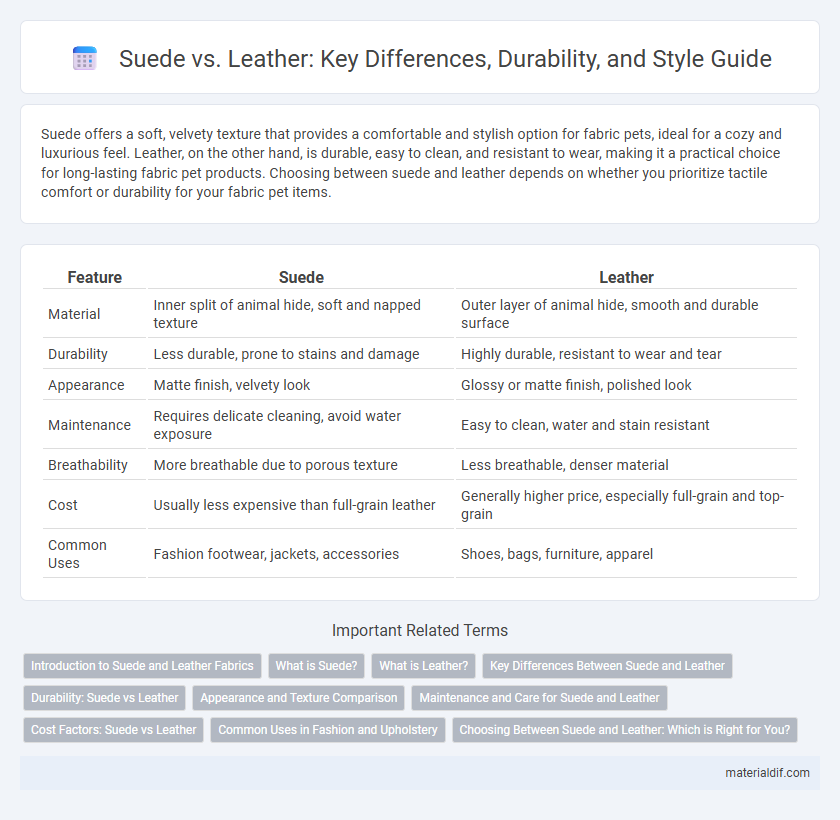Suede offers a soft, velvety texture that provides a comfortable and stylish option for fabric pets, ideal for a cozy and luxurious feel. Leather, on the other hand, is durable, easy to clean, and resistant to wear, making it a practical choice for long-lasting fabric pet products. Choosing between suede and leather depends on whether you prioritize tactile comfort or durability for your fabric pet items.
Table of Comparison
| Feature | Suede | Leather |
|---|---|---|
| Material | Inner split of animal hide, soft and napped texture | Outer layer of animal hide, smooth and durable surface |
| Durability | Less durable, prone to stains and damage | Highly durable, resistant to wear and tear |
| Appearance | Matte finish, velvety look | Glossy or matte finish, polished look |
| Maintenance | Requires delicate cleaning, avoid water exposure | Easy to clean, water and stain resistant |
| Breathability | More breathable due to porous texture | Less breathable, denser material |
| Cost | Usually less expensive than full-grain leather | Generally higher price, especially full-grain and top-grain |
| Common Uses | Fashion footwear, jackets, accessories | Shoes, bags, furniture, apparel |
Introduction to Suede and Leather Fabrics
Suede is a type of leather with a napped finish, created from the underside of animal hides, offering a soft texture and matte appearance, commonly used in fashion and upholstery. Leather, derived from the outer layer of animal hides, is durable, smooth, and often treated for water resistance, making it ideal for jackets, shoes, and accessories. Both fabrics differ in texture, durability, and maintenance requirements, influencing their suitability for various applications.
What is Suede?
Suede is a type of leather made from the underside of animal hides, primarily from lamb, goat, or calf, characterized by its soft, napped finish and velvety texture. Unlike traditional leather, suede is more porous and breathable but less durable and more susceptible to water and stains, requiring careful maintenance. Its unique fibrous surface makes suede a popular choice for stylish apparel and accessories, offering a distinct tactile and visual appeal compared to smooth-grain leather.
What is Leather?
Leather is a durable and flexible material created by tanning animal hides, primarily from cows, to preserve and enhance the natural strength of the skin. It offers excellent resistance to wear, making it a popular choice for upholstery, footwear, and accessories. Leather's natural grain structure provides breathability and a distinct texture that improves with age and use.
Key Differences Between Suede and Leather
Suede is a type of leather with a napped finish created from the underside of animal skin, offering a soft and textured surface, while leather is made from the smooth, outer hide providing a durable and polished appearance. Suede is more porous and susceptible to stains and water damage compared to leather, which is typically more resistant and easier to clean. The key differences between suede and leather also lie in their uses, with suede favored for fashion items due to its softness and leather preferred for products requiring toughness and longevity.
Durability: Suede vs Leather
Leather exhibits superior durability compared to suede due to its dense fiber structure and resistance to wear, making it ideal for long-lasting use in garments and accessories. Suede, derived from the underside of animal hide, is softer and more prone to scuffing, moisture damage, and staining, which reduces its overall lifespan. While leather withstands rough conditions and frequent handling better, suede requires careful maintenance to preserve its texture and appearance.
Appearance and Texture Comparison
Suede features a soft, napped finish with a matte appearance, providing a velvety texture that feels smooth and pliable to the touch. Leather showcases a polished, glossy surface that varies from smooth to slightly textured depending on the tanning process, offering a firmer and more resilient feel. The visual contrast between suede's muted softness and leather's sleek shine highlights their distinct tactile qualities and aesthetic appeal in fashion and upholstery.
Maintenance and Care for Suede and Leather
Suede requires gentle maintenance using a suede brush to remove dirt and prevent damage to the delicate nap, along with specialized suede cleaners for stains. Leather demands regular conditioning with leather-specific creams or oils to maintain its suppleness and prevent cracking, while cleaning should be done with a damp cloth or leather cleaner. Both materials benefit from protection sprays to repel water and stains, extending the lifespan of suede and leather products.
Cost Factors: Suede vs Leather
Suede generally costs less than full-grain leather due to the lower quality of hide used and simpler processing methods. Leather, especially full-grain or top-grain varieties, involves more intensive tanning and finishing processes, contributing to higher prices. Maintenance expenses also influence overall cost, as suede requires specialized cleaning products, while leather can be treated with more readily available conditioners.
Common Uses in Fashion and Upholstery
Suede is commonly used in fashion for items like jackets, shoes, and handbags due to its soft texture and matte finish, while leather is preferred for durable products such as belts, wallets, and structured footwear. In upholstery, leather is favored for its durability, ease of cleaning, and ability to develop a natural patina, making it ideal for sofas and car seats, whereas suede is less common due to its sensitivity to stains and wear. Both materials are integral to fashion and interior design, but their different textures and maintenance needs guide their specific applications.
Choosing Between Suede and Leather: Which is Right for You?
Suede offers a soft, textured feel ideal for casual and stylish applications, but requires careful maintenance to avoid stains and damage from moisture. Leather provides durability, water resistance, and a polished appearance, making it suitable for long-lasting and versatile use. Choosing between suede and leather depends on your lifestyle, climate, and intended use, balancing aesthetics with practicality.
Suede vs Leather Infographic

 materialdif.com
materialdif.com